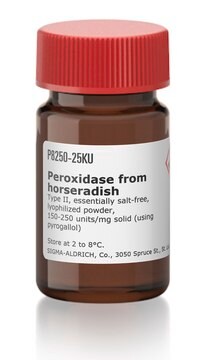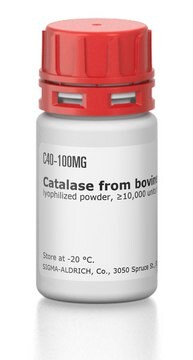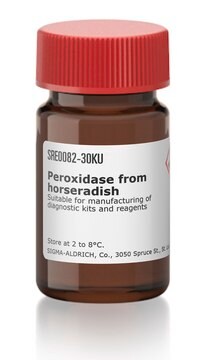추천 제품
생물학적 소스
Aspergillus niger
양식
powder
품질
lyophilized
특이 활성도
~200 U/mg
분자량
Mr ~186000
외래 활성
catalase ≤1%
배송 상태
dry ice
저장 온도
−20°C
InChI
1S/C6H12O6/c7-1-2-3(8)4(9)5(10)6(11)12-2/h2-11H,1H2/t2-,3-,4+,5-,6-/m1/s1
InChI key
WQZGKKKJIJFFOK-VFUOTHLCSA-N
유사한 제품을 찾으십니까? 방문 제품 비교 안내
일반 설명
Molecular Weight: 160 kDa (gel filtration)
pI: 4.2
Extinction coefficient: E1% = 16.7 (280 nm)
Glucose oxidase from Aspergillus niger is a dimer consisting of 2 equal subunits with a molecular mass of 80 kDa each. Each subunit contains one flavin adenine dinulceotide moiety and one iron. The enzyme is a glycoprotein containing ~16% neutral sugar and 2% amino sugars. The enzyme also contains 3 cysteine residues and 8 potential sites for N-linked glycosylation.
Glucose oxidase is capable of oxidizing D-aldohexoses, monodeoxy-D-glucoses, and methyl-D-glucoses at varying rates.
The pH optimum for glucose oxidase is 5.5, while it has a broad activity range of pH 4-7. Glucose oxidase is specific for β-D-glucose with a KM of 33-110 mM.
Glucose oxidase does not require any activators, but it is inhibited by Ag+, Hg2+, Cu2+, phenylmercuric acetate, and p-chloromercuribenzoate. It is not inhibited by the nonmetallic SH reagents: N-ethylmaleimide, iodoacetate, and iodoacetamide.
Glucose oxidase can be utilized in the enzymatic determination of D-glucose in solution. As glucose oxidase oxidizes β-D-glucose to D-gluconolactate and hydrogen peroxide, horseradish peroxidase is often used as the coupling enzyme for glucose determination. Although glucose oxidase is specific for β-D-glucose, solutions of D-glucose can be quantified as α-D-glucose will mutorotate to β-D-glucose as the β-D-glucose is consumed by the enzymatic reaction.
pI: 4.2
Extinction coefficient: E1% = 16.7 (280 nm)
Glucose oxidase from Aspergillus niger is a dimer consisting of 2 equal subunits with a molecular mass of 80 kDa each. Each subunit contains one flavin adenine dinulceotide moiety and one iron. The enzyme is a glycoprotein containing ~16% neutral sugar and 2% amino sugars. The enzyme also contains 3 cysteine residues and 8 potential sites for N-linked glycosylation.
Glucose oxidase is capable of oxidizing D-aldohexoses, monodeoxy-D-glucoses, and methyl-D-glucoses at varying rates.
The pH optimum for glucose oxidase is 5.5, while it has a broad activity range of pH 4-7. Glucose oxidase is specific for β-D-glucose with a KM of 33-110 mM.
Glucose oxidase does not require any activators, but it is inhibited by Ag+, Hg2+, Cu2+, phenylmercuric acetate, and p-chloromercuribenzoate. It is not inhibited by the nonmetallic SH reagents: N-ethylmaleimide, iodoacetate, and iodoacetamide.
Glucose oxidase can be utilized in the enzymatic determination of D-glucose in solution. As glucose oxidase oxidizes β-D-glucose to D-gluconolactate and hydrogen peroxide, horseradish peroxidase is often used as the coupling enzyme for glucose determination. Although glucose oxidase is specific for β-D-glucose, solutions of D-glucose can be quantified as α-D-glucose will mutorotate to β-D-glucose as the β-D-glucose is consumed by the enzymatic reaction.
애플리케이션
Glucose oxidase is widely used in the food and pharmaceutical industries as well as a major component of glucose biosensors.
생화학적/생리학적 작용
Glucose oxidase catalyses the oxidation of β-d-glucose to d-glucono-β-lactone and hydrogen peroxide, with molecular oxygen as an electron acceptor.
단위 정의
1 U corresponds to the amount of enzyme which oxidizes 1 μmol glucose per minute at pH 7.0 and 25 °C
One unit will oxidize 1.0 μmole of β-D-glucose to D-gluconolactone and H2O2 per min at pH 5.1 at 35 °C, equivalent to an O2 uptake of 22.4 μl per min. If the reaction mixture is saturated with oxygen, the activity may increase by up to 100%.
신호어
Danger
유해 및 위험 성명서
예방조치 성명서
Hazard Classifications
Resp. Sens. 1
Storage Class Code
11 - Combustible Solids
WGK
WGK 1
개인 보호 장비
dust mask type N95 (US), Eyeshields, Faceshields, Gloves
이미 열람한 고객
Alex J Wadley et al.
Methods in molecular biology (Clifton, N.J.), 1990, 53-70 (2019-05-31)
Increased production of reactive oxygen species (ROS) and deficiencies in cellular antioxidant defenses are the principal causes of cellular oxidative stress. ROS can react with a variety intracellular molecules, including redox active cysteine thiols (-SH) within proteins. Cysteine thiols can
Zhichao Fan et al.
Cell reports, 26(1), 119-130 (2019-01-04)
Leukocyte adhesion requires β2-integrin activation. Resting integrins exist in a bent-closed conformation-i.e., not extended (E-) and not high affinity (H-)-unable to bind ligand. Fully activated E+H+ integrin binds intercellular adhesion molecules (ICAMs) expressed on the opposing cell in trans. E-H-
Geetika Aggarwal et al.
The Journal of biological chemistry, 297(3), 101019-101019 (2021-08-01)
Reduced activity of paraoxonase 1 (PON1), a high-density lipoprotein (HDL)-associated enzyme, has been implicated in the development of atherosclerosis. Post-translational modifications of PON1 may represent important mechanisms leading to reduced PON1 activity. Under atherosclerotic conditions, myeloperoxidase (MPO) is known to
Man Sup Kwak et al.
Redox biology, 24, 101203-101203 (2019-04-27)
The nuclear protein HMGB1 (high mobility group box 1) is secreted by monocytes-macrophages in response to inflammatory stimuli and serves as a danger-associated molecular pattern. Acetylation and phosphorylation of HMGB1 are implicated in the regulation of its nucleocytoplasmic translocation for
Zhengpeng Yang et al.
Biosensors & bioelectronics, 51, 268-273 (2013-08-27)
Core-shell Fe3O4-enzyme-polypyrrole (Ppy) nanoparticles with excellent magnetism and conductivity were successfully prepared via the surface modification and enzyme self-encapsulation within Ppy. A novel potentiometric glucose biosensor has been constructed by effectively attaching the proposed Fe3O4-enzyme-Ppy nanoparticles to the surface of
자사의 과학자팀은 생명 과학, 재료 과학, 화학 합성, 크로마토그래피, 분석 및 기타 많은 영역을 포함한 모든 과학 분야에 경험이 있습니다..
고객지원팀으로 연락바랍니다.







